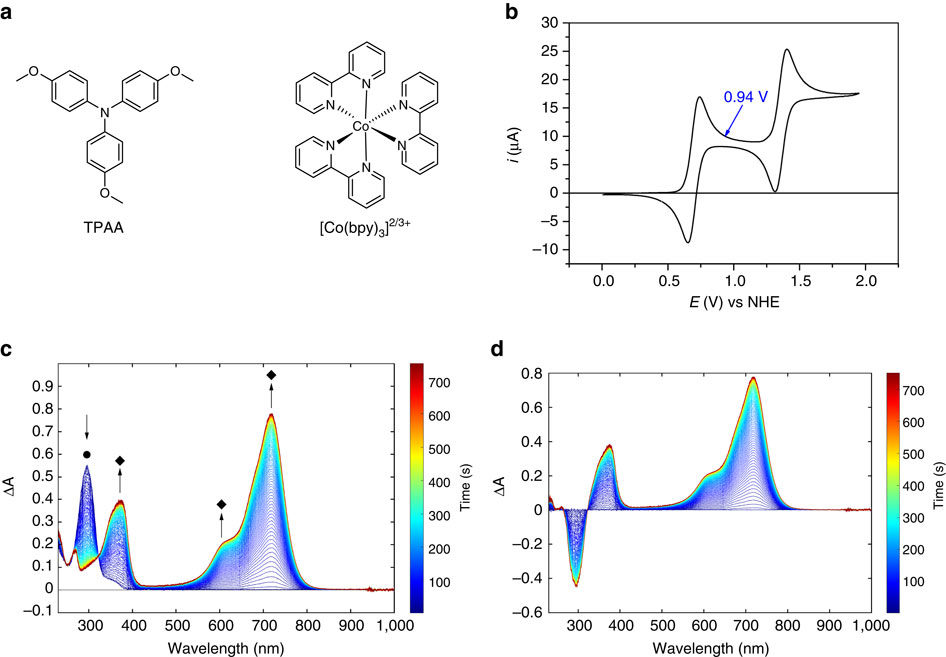当前位置:
X-MOL 学术
›
Nat. Commun.
›
论文详情
Our official English website, www.x-mol.net, welcomes your
feedback! (Note: you will need to create a separate account there.)
A small electron donor in cobalt complex electrolyte significantly improves efficiency in dye-sensitized solar cells.
Nature Communications ( IF 14.7 ) Pub Date : 2016-12-21 , DOI: 10.1038/ncomms13934
Yan Hao , Wenxing Yang , Lei Zhang , Roger Jiang , Edgar Mijangos , Yasemin Saygili , Leif Hammarström , Anders Hagfeldt , Gerrit Boschloo
Nature Communications ( IF 14.7 ) Pub Date : 2016-12-21 , DOI: 10.1038/ncomms13934
Yan Hao , Wenxing Yang , Lei Zhang , Roger Jiang , Edgar Mijangos , Yasemin Saygili , Leif Hammarström , Anders Hagfeldt , Gerrit Boschloo

|
Photoelectrochemical approach to solar energy conversion demands a kinetic optimization of various light-induced electron transfer processes. Of great importance are the redox mediator systems accomplishing the electron transfer processes at the semiconductor/electrolyte interface, therefore affecting profoundly the performance of various photoelectrochemical cells. Here, we develop a strategy-by addition of a small organic electron donor, tris(4-methoxyphenyl)amine, into state-of-art cobalt tris(bipyridine) redox electrolyte-to significantly improve the efficiency of dye-sensitized solar cells. The developed solar cells exhibit efficiency of 11.7 and 10.5%, at 0.46 and one-sun illumination, respectively, corresponding to a 26% efficiency improvement compared with the standard electrolyte. Preliminary stability tests showed the solar cell retained 90% of its initial efficiency after 250 h continuous one-sun light soaking. Detailed mechanistic studies reveal the crucial role of the electron transfer cascade processes within the new redox system.
中文翻译:

钴复合电解质中的一个小的电子供体大大提高了染料敏化太阳能电池的效率。
用于太阳能转换的光电化学方法要求对各种光诱导的电子转移过程进行动力学优化。氧化还原介体系统在半导体/电解质界面处完成电子转移过程非常重要,因此深刻影响了各种光电化学电池的性能。在这里,我们制定了一项策略,即在现有技术的三(联吡啶)氧化钴钴中添加一种小的有机电子给体三(4-甲氧基苯基)胺,以显着提高染料敏化太阳能电池的效率。所开发的太阳能电池在0.46和一太阳光下的效率分别为11.7和10.5%,与标准电解质相比,效率提高了26%。初步的稳定性测试表明,在连续太阳光浸泡250小时后,太阳能电池保留了其初始效率的90%。详细的机理研究揭示了新的氧化还原系统中电子转移级联过程的关键作用。
更新日期:2016-12-22
中文翻译:

钴复合电解质中的一个小的电子供体大大提高了染料敏化太阳能电池的效率。
用于太阳能转换的光电化学方法要求对各种光诱导的电子转移过程进行动力学优化。氧化还原介体系统在半导体/电解质界面处完成电子转移过程非常重要,因此深刻影响了各种光电化学电池的性能。在这里,我们制定了一项策略,即在现有技术的三(联吡啶)氧化钴钴中添加一种小的有机电子给体三(4-甲氧基苯基)胺,以显着提高染料敏化太阳能电池的效率。所开发的太阳能电池在0.46和一太阳光下的效率分别为11.7和10.5%,与标准电解质相比,效率提高了26%。初步的稳定性测试表明,在连续太阳光浸泡250小时后,太阳能电池保留了其初始效率的90%。详细的机理研究揭示了新的氧化还原系统中电子转移级联过程的关键作用。































 京公网安备 11010802027423号
京公网安备 11010802027423号